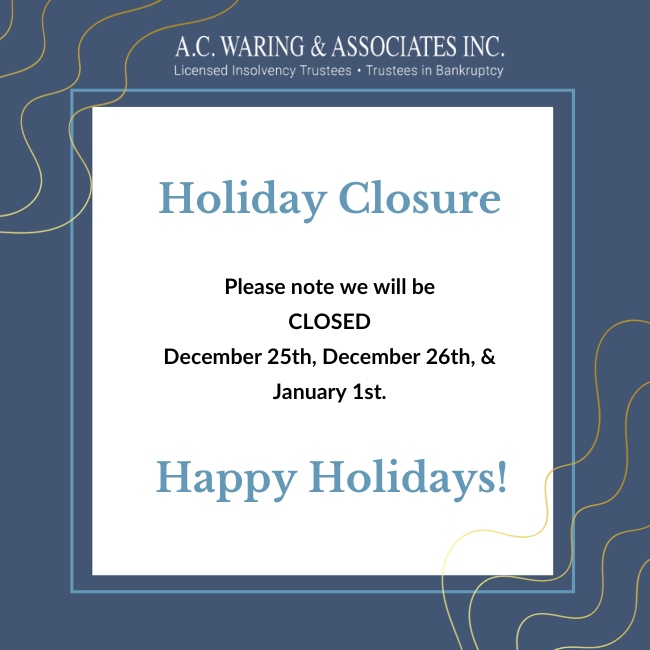Filing for bankruptcy protection can be an emotionally tumultuous time, especially when you’re faced with dealing with your debt anxiety and trying to figure out how best to resolve this. There are some alternatives to bankruptcy that may fit your situation. Your trustee or counsellor will tell you about them. However, depending on the extent of your situation, declaring bankruptcy may be your most viable option. Fortunately, filing for bankruptcy is meant to relieve you of your obligations. The trustee’s role will be to take over those obligations and deal with your creditors. Bankruptcy trustees work to help you get your financial life back on track.
Who Should File for Bankruptcy?
Your trustee will advise you of all alternatives. Sometimes the best option is bankruptcy for all the reasons you and your trustee will discuss. The most common alternatives to filing for bankruptcy may include discussing debt consolidation, consumer proposals, orderly payment of debts and debt repayment plans. Each of these has benefits and limitations and, depending on your individual circumstances, your situation may or may not be limited to fewer options. As you receive counsel and instructions from your trustee, you will become informed about which options are available to you, why, and what actions are advised in your case.
People sometimes feel ashamed if they file for bankruptcy. This stigma is old fashioned, but we realize it still exists. If you do file for bankruptcy, you’re not alone—approximately 100,000 Canadians file for personal bankruptcy annually and on top of that, numerous businesses do too.
Like others in your situation, your credit rating has already been severely affected due to late payments, no payments or chronic problems about repayment. It’s likely that, prior to filing for bankruptcy, you already have a low credit rating and have been turned down for loans, etc. Bankruptcy will not make that much of a difference to your rating in this case. It can actually give you more of a fresh financial start.
How Do I File for Bankruptcy?
The first step is to meet with a bankruptcy trustee licensed by Industry Canada through the Office of the Superintendent of Bankruptcy (OSB). They will help you assess your financial situation and advise you of your options. If the assessed options result in a Notice of Intention or a Consumer Proposal or filing for Bankruptcy Protection, there will be an immediate stay of creditor actions against you – creditor calls and collection notices will cease, as will foreclosures, repossessions, and debt-collection suits.
This stay allows us to help you or your business create a plan by which you will pay as much debt as you can, either through sale of non-exempt assets for a lump sum payment or a short-term payment schedule, both of which usually have you repaying far less than what is owed. The method we will take for you will be determined by your individual circumstances. A.C. Waring & Associates can help you make a plan to get out of your financial difficulties.
Bankruptcy is declared once your trustee files the official documents with the court. This means that all your creditors’ actions against you must stop immediately. Instead, your trustee will act as a go-between: he or she will intercede directly to your creditors. Applicable lawsuits against you must stop, as well as salary garnishees and payments to unsecured creditors.
You will also attend two mandatory financial credit counseling meetings where a financial counselor will discuss your situation and create a financial plan with you to avoid similar situations from happening again.
Depending on the circumstances, you might also take these steps as part of your bankruptcy:
- The OSB might examine you under oath to better understand what caused your bankruptcy, and to ask you about your conduct leading up to the bankruptcy.
- Your creditors might require a meeting with you and your trustee where they will request more information about the bankruptcy.
- As well as paying your regulated trustee’s fees, you might need to make surplus income payments to your trustee which he or she will distribute to your creditors. Your surplus income is extra income that exceeds the amount of money a family would need to maintain its standard of living.
Finally, you will be discharged from your bankruptcy, which frees you from your obligation to repay debts dating to before your bankruptcy, except for certain payments such as alimony or child support.
What Are the Pros and Cons of Filing for Bankruptcy?
PROS
- Monetary cost is less than any other option.
- Proceedings are usually completed in nine months.
- Applicable assets become vested in the Trustee as the official between the debtor and the creditors.
- Payments are determined by the standard set out by the Superintendent of Bankruptcy.
- Provisions can be made to increase retained income for exceptional expenses like child maintenance, etc.
- Providing a co-signer is not necessary.
- It is not necessary to know the exact amount of money owed to creditors.
- The stigma of bankruptcy is less in today’s society. The public is more accepting of the reality of the marketplace and of personal circumstances.
- Bankruptcy protects some assets from seizure.
- Bankruptcy halts debt collection.
- Increased tax assessments on income prior to bankruptcy usually have no effect on eventual discharge or required payments to your bankruptcy.
- Surplus income may be used to allay child maintenance and alimony arrears.
- The Trustee acts as the professional between the debtor and the creditors.
CONS
- Co-signers on loans will still be responsible for the loan.
- Some debts may withstand bankruptcy.
- Credit cards must be destroyed.
- Credit rating will already be affected by prior Bureau notifications by creditors due to debtor history of late or non-payment, let alone bankruptcy.
- Non-exempt assets must be vetted by the Trustee.
- Self-employed restrictions may apply.
Many possessions are protected by law. Each province has certain exempted items. For instance, in Alberta, the following items are exempt:
- Household furniture up to $4,000
- 12 months’ supply of food
- Up to $4,000 of clothes
- One motor vehicle up to $5,000
- Up to 160 acres of farm lands for farmers
- Tools of the trade necessary for you to work
- Health aids
While surrendering other assets can be hard, doing so also alleviates you from the crushing debt that has been smothering you for the last while. Surrendering your assets is certainly a trade-off, but when it’s necessary, it can help you eliminate some of the emotional stress caused by exhausting, unending debt.
Moving Forward
If circumstances require you to file for bankruptcy, understanding the process and how your trustee can help you is the best way to use your bankruptcy to your advantage. When you understand the ins and outs of bankruptcy and take full advantage of benefits like relief from your original debt amount, financial counseling support, and trustee intervention with your creditors you can emerge from the situation financially wiser and emotionally freer.




